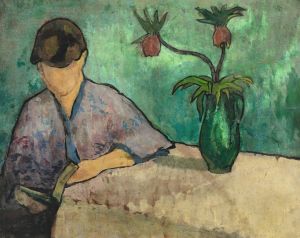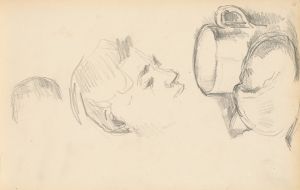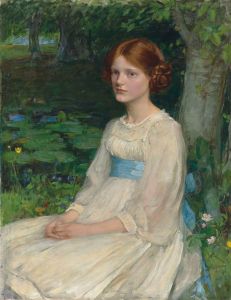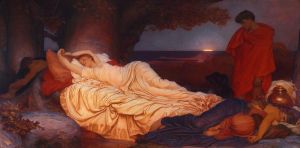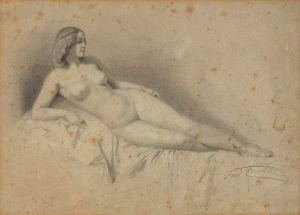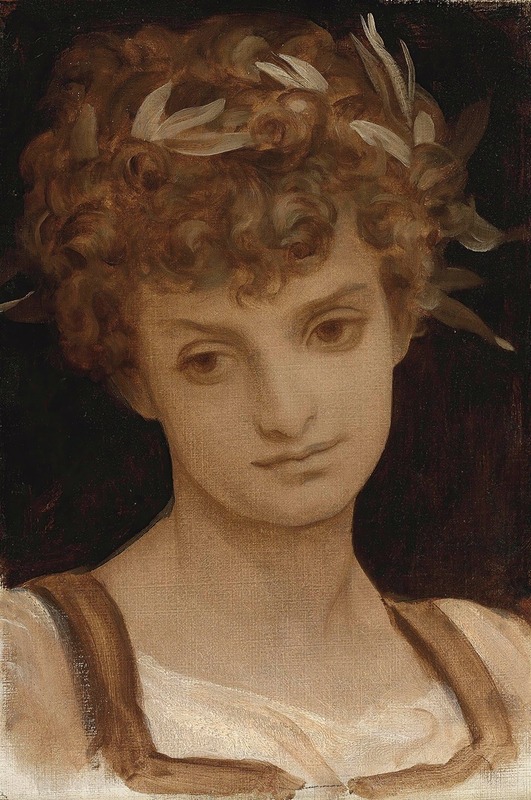
Study Of A Girl’s Head, Wreathed In Laurel
A hand-painted replica of Frederic Leighton’s masterpiece Study Of A Girl’s Head, Wreathed In Laurel, meticulously crafted by professional artists to capture the true essence of the original. Each piece is created with museum-quality canvas and rare mineral pigments, carefully painted by experienced artists with delicate brushstrokes and rich, layered colors to perfectly recreate the texture of the original artwork. Unlike machine-printed reproductions, this hand-painted version brings the painting to life, infused with the artist’s emotions and skill in every stroke. Whether for personal collection or home decoration, it instantly elevates the artistic atmosphere of any space.
"Study of a Girl’s Head, Wreathed in Laurel" is a painting by the renowned British artist Frederic Leighton, 1st Baron Leighton (1830–1896). Leighton was a leading figure in the Victorian art world and is best known for his association with the Aesthetic Movement, which emphasized beauty and visual harmony over narrative content in art.
This particular work, "Study of a Girl’s Head, Wreathed in Laurel," is a fine example of Leighton’s skill in portraiture and his ability to capture the delicate features and expressions of his subjects. The painting depicts the head of a young girl adorned with a laurel wreath, a symbol often associated with victory and honor in classical antiquity. The choice of a laurel wreath may reflect Leighton’s interest in classical themes and his desire to imbue his works with a sense of timeless beauty.
Leighton’s technique in this study is characterized by his meticulous attention to detail and his use of soft, harmonious colors. The girl’s face is rendered with a gentle, almost ethereal quality, highlighting Leighton’s mastery in capturing the subtleties of human expression. The laurel wreath, with its intricate leaves, is painted with precision, adding a touch of classical elegance to the composition.
The painting is likely a preparatory study, a common practice among artists of Leighton’s time, where they would create detailed studies of individual elements before incorporating them into larger, more complex works. Such studies allowed artists to experiment with composition, lighting, and form, ensuring that the final piece would achieve the desired effect.
Frederic Leighton’s works often reflect his academic training and his exposure to the art and culture of Europe. He spent significant time in Italy, where he was influenced by the Renaissance masters, and this influence is evident in the classical themes and techniques present in his work. Leighton’s art is also marked by his interest in the human form, which he depicted with a sense of grace and idealized beauty.
"Study of a Girl’s Head, Wreathed in Laurel" exemplifies Leighton’s dedication to the principles of the Aesthetic Movement, focusing on beauty and form rather than narrative or moral content. This approach was somewhat revolutionary in the Victorian era, which often favored art with clear moral or educational messages.
Leighton’s contribution to the art world was significant, and he was highly respected by his contemporaries. He served as the President of the Royal Academy of Arts from 1878 until his death in 1896, and his works continue to be celebrated for their beauty and technical excellence.
In summary, "Study of a Girl’s Head, Wreathed in Laurel" is a testament to Frederic Leighton’s artistic skill and his commitment to the ideals of beauty and harmony. The painting remains an important piece within the context of Victorian art and continues to be appreciated by art enthusiasts and scholars alike.






